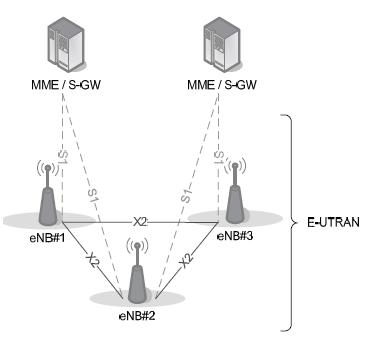LTE access network and E-UTRAN, the network comprises a eNodeBs, as shown in Fig. For the normal user traffic (as opposed to transmission), there is no centralized controller in E-UTRAN, thus, E-UTRAN architecture is called flat.
The eNodeBs are usually inter-connected together through an interface known as X2, and the EPC interface through S1 – more specifically to the MME through the S1-MME interface and the S-GW through of the S1-U interface. Protocols running between eNodeBs and UE are known as access stratum protocols (AS).
E-UTRAN is responsible for all radio-related functions, which can be summarized as follows:
Radio Resource Management : This applies to all the functions associated with radio channels, such as radio control bearer admission control radio, radio mobility management, planning, and dynamic resource allocation for UE, both in the uplink and downlink.
Header Compression: This helps to ensure efficient use of the radio interface by compressing packet headers IP, which could be a significant overhead, especially for small packets, such as VoIP.
Security: All data transmitted over the radio interface is encrypted.
Positioning: E-UTRAN provides the necessary measurements and other data from E-SMLC and the E-SMLC helps in finding the position of UE.
Connectivity to the EPC: It consists of a signal to the MME and the carrier path to the S-GW.
On the network side, all these functions are eNodeBs, each of which may be responsible for the management of multiple cells. Unlike some of the previous second and third generation technology, LTE integrates the function of the radio controller eNodeB. This allows the close interaction between the various layers of the radio access network protocol, thereby reducing the delay and improving efficiency.
Such distributed control eliminates the need for high availability, intensive processing controller, which in turn has the potential to reduce costs and avoid the “single point of failure. Furthermore, as LTE does not support soft handoff there is no need centralized data combining functions in the network.
One consequence of the lack of a centralized node controller is that when the UE, the network shall transmit all information related to the UE, i.e. Context UE, and any buffered data, eNodeB from one to another. Mechanisms is therefore essential to avoid data loss during transmission.
An important feature of the S1 interface to the communication access network is known as the base S1-flexibility. This concept which several nodes CN (MME / S-GW) can serve a common geographic area, a cellular network being connected to the set oblasti. ENodeB eNodeBs in this way can be served by several MME / S-GW.
Many MME / S-GW nodes serving a common area is called MME / S-GW pool and the area covered by this pool MME / S-GW pool called. This concept allows the UE, in the cell (s) controlled by one eNodeB be shared between multiple nodes CN, thus making it possible to distribute the load, and the elimination of single points of failure for the CN nodes. Context of UE usually stays the same MME until the UE is within the basin.
